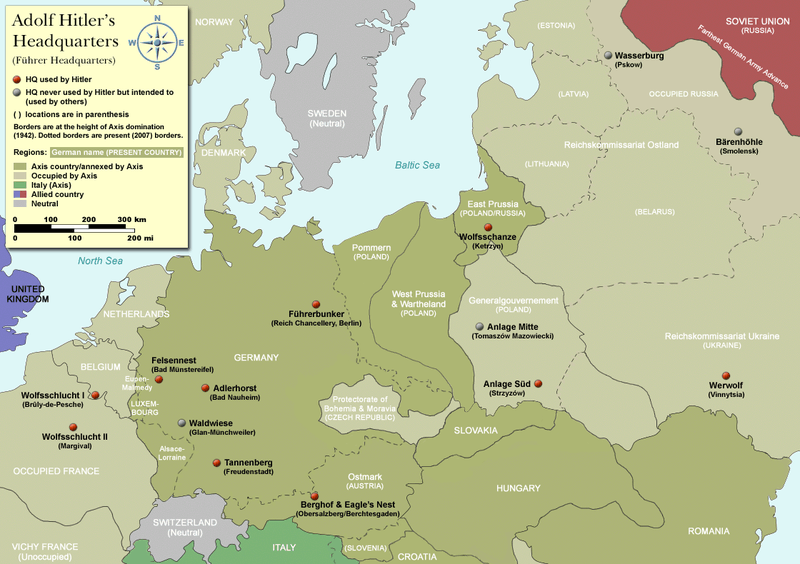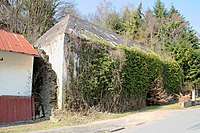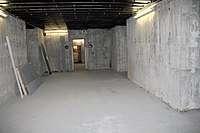Adlerhorst

Adlerhorst (Eagle's eyrie) was a World War II bunker complex in Germany, located in the rural area of Langenhain-Ziegenberg, Wiesental Wetterau and Kransberg in the Taunus mountains in the state of Hesse.
Designed by Albert Speer as Adolf Hitler's main military command complex, it was reassigned by Hitler in February 1940 to Luftwaffe chief Hermann Göring as his headquarters for the Battle of Britain, serving as Hitler's only during the Dec. 1944- Jan. 1945 Ardennes Offensive.
Background

There were no official Führer Headquarters before World War II because Hitler used either existing military complexes, or mobile facilities close to the battle lines. Under plans developed by Martin Bormann and architectural designs by Speer, a series of Führer complexes were built. The best known were: the Führerbunker in Berlin; the Berghof complex in Berchtesgaden, Bavaria; and the Wolfsschanze near Kętrzyn in modern-day Poland.
Austrian noble Emma von Scheitlein acquired Kransberg Castle in the village of Kransberg in 1926, and used it for society events. Chosen due to its central location as the proposed main military command headquarters of Hitler, it was appropriated by the Nazi government in 1939. Speer immediately began adapting it, designing military-grade infrastructure which was well disguised and adapted to fit-in with its surroundings.
Construction
The main complex was a collection of seven cottages, in a heavily wooded compound beyond the castle's main entrance.[1] Although each building was designed as an air raid bunker with 3 feet (0.91 m) thick concrete walls, each had the appearance of a traditional locally built Fachwerk (half-timbered) style wooden cottage, complete with second storey dormer windows and flower baskets under a sloped tiled roof. Internally, each was furnished in traditional German style with oak floors, pine wall paneling, utilitarian leather upholstered furniture, and decorated with fringed shade wall lamps, wall hangings depicting hunting scenes or Teutonic battles, and a set of deer antlers.
The cottages were numbered and allocated as follows:[2]

- Haus 1: The Führer's house. In keeping with Hitler's preferences, it was no more luxuriously appointed than the other six.
- Haus 2: Also referred to as the "casino." This was German military terminology for an officers' club. In addition to a lounge and café at ground level, and bedrooms on the second floor, the building contained an entrance to the bunker below it, giving immediate access to a secure situation room and coded communications center.
- Haus 3: The Oberkommando der Wehrmacht-house (OKW). This was designed as the residence of the commanding general, and during its use housed Rundstedt, Jodl, Kesselring, Göring and Keitel.
- Haus 4: Known as the "generals' house." This was occupied by the second echelon of the general staff, including Manteuffel, Schörner and Guderian.
- Haus 5: The so-called Pressehaus. This was occupied by an arm of Goebbels' propaganda ministry.
- Haus 6: The Reichsleiters' residence. This offered accommodation for top-level political leaders, such as, Martin Bormann, Alfred Rosenberg and Robert Ley, who came to consult and advise the Führer.
- Haus 7: The Wachhaus. The largest building on the site, designed to house the Führer's offices and his personal security, secretarial and housekeeping staffs. Built on top of a bunker base, the building was connected to the castle by a .5 miles (0.80 km) long bunker. With one wall exposed, the bunker was camouflaged as a stone retaining wall. To add authenticity, grape vines were planted and grew onto the stone wall.
Located in the village itself was the largest building of all, the fortified Kraftfahrzeughalle or motor pool garage. Even though its purpose was purely military, in addition to being a garage for a large fleet of armored limousines, fire engines, busses and ambulances, it also had a Fachwerk-style housing for the families of the personnel assigned to them.[2] Above the castle and compound, located to the north in the hills, was a disguised Wehrmacht depot.[1]
To build the complex quickly and without the knowledge of local residents, construction workers from Organisation Todt were brought in from other regions. The entire area was ringed with camouflaged anti-aircraft batteries, constructed first to deflect suspicion about the importance of the site. The locals were told that it was an expansion of the air defense zone of Bad Münstereifel. No evidence existed in post-war records to support that the construction phase was anything but successful in covering up the complex's purpose. No notes or briefings were uncovered to suggest that its purpose was known beyond Hitler's inner-circle of its construction or importance.[2]
Operations
During construction of Adlerhorst, Hitler had used the castle to plan some of the early western campaigns, including the Battle of France and the drive to Dunkirk.[2]
After the completion of construction, quick approval was given for operation. However, after a visit by Hitler in February 1940, he dismissed it as an operational base, as he considered it too lavish for his Spartan taste (and image as a man of the people). Thus, Speer was asked to adapt the complex to meet the needs for use by the Luftwaffe, and specifically to serve as the Luftwaffe headquarters for Hermann Göring during Operation Sea Lion, and the invasion of Great Britain.
Hitler’s Directive No. 16 (the order initiating Sealion) nominated the ‘Adlerhorst’ (Eagles Nest) at Ziegenberg as the Sealion headquarters. The directive ordered the headquarters for each of the services to set up nearby. The Army and the Navy were to occupy mutual premises in the Army Headquarters at Giessen while the Luftwaffe was to move its headquarters train to Ziegenberg. Ziegenberg is north of Frankfurt and 32 km from Giessen, but it was usual at that time for the German armed service headquarters to be separated by distances up to 50km during a major operation. For example, Goering’s HQ was located 50 km from Felsennest, Hitler’s HQ for the invasion of France (10 May-6 June 1940) [3] This distance did not prevent that operation from being successful. Although Hitler didn’t move to the purpose built Führerhauptquartier, he may have done so had the plan been put into execution. His 1,100 man bodyguard, the Fuhrer-Begleitbataillon, plus a 600 man Luftwaffe anti-aircraft detachment, moved to Adlerhorst 5 July 1940 in anticipation of Hitler’s arrival. They didn’t leave until November 25 1940. [4]
When plans for the invasion of Britain were abandoned in favour of Operation Barbarossa, the invasion of the Soviet Union, the castle and complex were put to use as a rehabilitation center for soldiers of all ranks, and allocated as Göring's personal retreat.[5]
Ardennes Offensive
After the 20 July plot attempt on Hitler's life, and the abandonment of the Wolfsschanze due to the advances of the Red Army, Hitler needed a new military base of operations for the forthcoming Ardennes Offensive.
Adlerhorst had been given additional security since 1943. To blend in with the pine-forested hilltop and to defy air detection, most of the cottages were further disguised with fake evergreen trees. From October 1944, Adlerhorst had also become the headquarters of the Commander in Chief of OB West, Gerd von Rundstedt.
Hitler arrived at Giessen station on his personal Führersonderzug (train) on 11 December 1944, taking up residence in Haus 1 until 16 January 1945.[2] Rundstedt who was to command Operation Wacht am Rhein set up his headquarters near Limburg, Belgium, close enough for the generals and Panzer Corps commanders who were planning the attack, to travel to Adlerhorst in an SS-operated bus convoy that evening. With the castle used to provide for overflow accommodation, the main party settled into Haus 2/the casino. Those present included generals Jodl, Keitel, Blumentritt, Manteuffel and S.S. colonel general Sepp Dietrich. Joined by Hitler, Rundstedt ran through the plans at 05:00 on December 15; the plan that envisaged the attack of three German armies consisting of over 250,000 men. Believing in omens and the successes of his early war campaigns that had been planned at Adlerhorst, Hitler rejoiced in the battles' early successes, taking long walks in the pine forest, regaling his team with his postwar plans and aspirations.[2]
Shortly after Christmas, Göring arrived and took up residence in the castle. After an extremely downbeat briefing in the casino, Göring privately suggested to Hitler that a truce be sought via his Swedish contacts. Hitler flew into a rage, and after threatening to have Göring put before a firing squad, mentally dismissed him as deputy Fuehrer.[2]
Operation Nordwind
After giving his 1945 New Year's speech from the Pressehaus, Hitler returned to Haus 1 to welcome in the New Year with his close friends and secretarial support team. At 04:00 he walked to the casino to watch the development of Operation Nordwind, his counter-offensive on New Year's Day.[2]
At midnight, nine Panzer divisions of Heeresgruppe G commanded by Generaloberst Johannes Blaskowitz had mounted an all-out attack on Bastogne. Then a faked diversionary attack was mounted by eight German divisions of Army Group Upper Rhine (Heeresgruppe Oberrhein) commanded by Heinrich Himmler, against the U.S. 7th Army and French 1st Army position, which was the thinly stretched line of 110 kilometres (68 mi) long, near Lembach in the Upper Vosges mountains in Alsace; 120 miles (190 km) to the southeast.
This defense line had been weakened by U.S. general Dwight D. Eisenhower, who had ordered troops, equipment and supplies north to reinforce the American armies involved in the Battle of the Bulge in the Ardennes. If successful, the German operation would have opened the way for Operation Zahnarzt, a planned major thrust into the rear of the U.S. 3rd Army.
However, having cracked the Enigma code machines, each German maneuver was either prepared for, or out-flanked by an allied counter-move. This resulted in a bitter attritional campaign that was lost from the 25th January onwards, with the Germans running out of replacement man power, machinery and supplies.[2]
Abandonment and attempted demolition
On 6 January 1945, a blockbuster bomb was jettisoned on Ziegenberg by a returning Allied bomber, damaging the church and several houses, killing four residents. With the Ardennes Offensive failed, and no new military plans or the resources with which to carry them out, the German military high command accepted that the western front was lost. Hitler left Adlerhorst on January 16, 1945, for Berlin.
Having been made commander of OB West on March 11, on March 17, Kesselring ordered all classified documents and sensitive equipment removed from the castle, moving himself and the command centre to the OKW house. On March 19, the Allies, once alerted of the original purpose of the complex, and not knowing if Hitler was still in residence, subjected the castle and surrounding area to a 45-minute fire bombing air raid by a squadron of P-51 Mustangs. This resulted in the loss of 10 civilian lives, and the castle and many of the surrounding buildings were damaged, destroyed or set on fire.[2]
On March 28, with the American army only 12 miles (19 km) away, using all available motor pool equipment, Kesselring ordered all civilian employees and families of military personnel to evacuate. German troops were instructed to dynamite the Fuehrer’s compound.[2]
Capture by Allied forces
The castle and village were captured by units of the U.S. Army on March 30, 1945. They found the compound as a burned-out jumbled mass of concrete bunkers bearing no resemblance to the original "wooden country house" design. But for some reason both the Wachhaus and the Pressehaus escaped demolition, both well preserved and with access to the remaining Adlerhorst bunker complex.
Soon afterwards a British-American detention center or Operation Dustbin, was moved from Paris and re-established in parts of the complex for high-ranking German non-military prisoners of war. It focused on key industrialists, scientists and economists; among those interrogated here were Hjalmar Schacht, Wernher von Braun, Ferdinand Porsche, and the leaders of the IG Farben chemical conglomerate. The highest-ranking of these persons of interest was the complex's original designer Albert Speer, who during his detention between June and August 1945 provided very open and detailed accounts of the inner workings of the Third Reich and the impact of Allied bombing of Germany.[6] Others interrogated here included Hjalmar Schacht[7] and many technical, financial and industrial leaders.[8]
Present

Most of the castle lay in ruins after the war, but in 1956 the Organisation Gehlen, the U.S.-German intelligence unit that later became the nucleus of the Bundesnachrichtendienst, moved in. It was later followed by V Corps (United States) which operated an NCO academy, and by U.S. intelligence units which directed large parts of its espionage network in communist East Germany from the castle. After a failed restoration attempt in the 1960s, in 1987 with US Army assistance the castle structure was rebuilt, with the stone walls clad in stucco. Returned to the reunified German government in 1990, it was subsequently sold to members of the family of the pre-war owner, and converted into luxury apartments from 1991.[2]
The Wachhaus and the Pressehaus are both preserved, with the Pressehaus an almost exact replica of the Führerhaus.
The Kraftfahrzeughalle motor pool building was not demolished. It was occupied for two years post war by a battalion of U.S. Army Combat Engineers. Converted into a US military hospital in 1977, it was returned to the West German Government in the same year. The half-timbered main hall still stands, and is presently occupied by offices and small businesses.[2]
The foundations of several of the compounds houses have been recycled for modern home and business construction, with the foundation of the OKW house now the basement for a hotel and bar named the Gasthaus Adlerhorst.[2]
References
- Raiber, Richard, Guide to Hitler's Headquarters, After The Battle, No.19
- Seidler, Franz W.; Zeigert, Dieter: Die Führerhauptquartiere. Anlagen und Planungen im Zweiten Weltkrieg. München 2000. Available in English as F W Siegler & D. Ziegert Hitler’s Secret Headquarters, Greenhill Books, London, 2004
- Rupp, Kurt: Das ehemalige Führerhauptquartier "Adlerhorst" mit den Bunkeranlagen in Langenhain-Ziegenberg. Ober-Mörlen 1997.(self-published)
- Hansen, Hans-Josef: Felsennest - Das vergessene Führerhauptquartier in der Eifel. Bau, Nutzung, Zerstörung. Helios Verlag, 2. erweiterte Neuauflage 2008. (darin auch Informationen und Fotos von Adlerhorst, S. 18-23)
- Sünkel, Werner; Rack, Rudolf; Rhode, Pierre: Adlerhorst - Autopsie eines Führerhauptquartiers. Verlag W.Sünkel Offenhausen 1998 unveränderte Neuauflage 2002. ISBN 3-930060-97-3
Notes
- 1 2 "Adlerhorst". bkffm.siemavisuart.de. Retrieved 2011-04-10.
- 1 2 3 4 5 6 7 8 9 10 11 12 13 14 Irwin J. Kappes. "Hitler's Ultra-Secret Adlerhorst". militaryhistoryonline.com. Archived from the original on 16 May 2011. Retrieved 11 April 2011.
- ↑ Seidler & Zeigert (2004), p.63.
- ↑ F W Siegler & D. Ziegert, Hitler’s Secret Headquarters, Greenhill Books, London, 2004, p. 75
- ↑ Ein dunkles Kapitel in der Geschichte des Schlosses (A Dark Chapter In The Castle's History). Usinger Anzeiger September 12, 2001 Archived July 21, 2007, at the Wayback Machine.
- ↑ Speer, Albert (2001). Schlie, Ulrich, ed. Alles, was ich weiß. F.A. Herbig Verlagsbuchhandlung. ISBN 3-7766-2092-7.
- ↑ https://books.google.ca/books?id=cS9zAwAAQBAJ&pg=PA96&lpg=PA96&dq=1945+may+speer+kransberg+castle&source=bl&ots=ydpoBxWcM5&sig=bsLqkHoyKY5YM6wmVNqS_gBqpTk&hl=en&sa=X&ved=2ahUKEwj0muj0-YXbAhWI2YMKHczUDWU4ChDoATABegQICBAB#v=onepage&q=1945%20may%20speer%20kransberg%20castle&f=false, p=95
- ↑ https://books.google.ca/books?id=n58KBgb8mz4C&pg=PA233&lpg=PA233&dq=kransberg+castle+1945+speer&source=bl&ots=Hzk4QllV-O&sig=Z0BCOPfZsyg0mWhazUvlAGtY4KE&hl=en&sa=X&ved=2ahUKEwini668-IXbAhUE8YMKHZokBpEQ6AEwEnoECAQQAQ#v=onepage&q=kransberg%20castle%201945%20speer&f=false, p=233]]